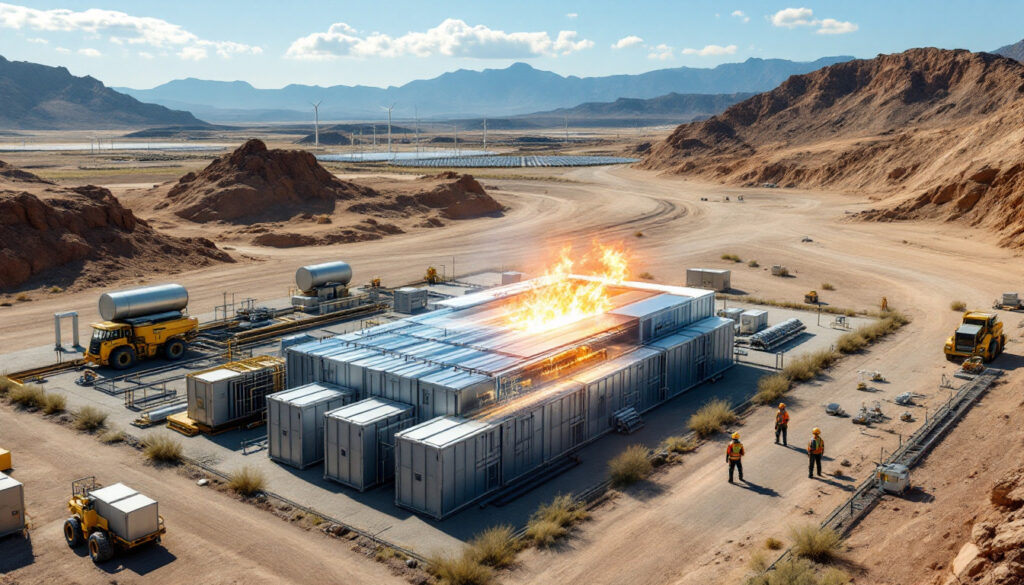Understanding Lithium-Ion Battery Risks in Mining Operations
The adoption of lithium-ion battery energy storage systems (BESS) in mining operations has surged due to their sustainability and cost-effectiveness. However, these systems introduce significant risks, including fire hazards from thermal runaway, propagation between units, and challenges in emergency response, particularly in remote locations. This report synthesizes current research, industry standards, and expert insights to provide a comprehensive risk management framework for how mining companies can manage lithium-ion risks.
What Are the Key Risks of Lithium-Ion Batteries in Mining?
Fire and Explosion Hazards
Lithium-ion batteries contain flammable electrolytes, such as lithium hexafluorophosphate, which pose significant fire risks in mining environments. These electrolytes can decompose at temperatures above 60°C, creating a dangerous situation for mining operations that often experience extreme conditions.
Thermal runaway occurs when batteries can't dissipate heat from chemical reactions fast enough. This self-perpetuating cycle can cause temperatures to spike to over 400°C within minutes, making conventional fire suppression approaches largely ineffective. According to FM Global's research, once thermal runaway begins, the temperature escalation rate can exceed 10°C per second in industrial-grade batteries.
Off-gassing during thermal runaway produces highly flammable and toxic gases including hydrogen, methane, and hydrogen fluoride. These gases not only sustain fires but create additional explosion risks in confined mining spaces. Research indicates that a single 50kWh battery module can release up to 6,000 liters of flammable gas during thermal runaway.
Battery fires can burn for 24+ hours even after apparent extinguishing. As Mike Hunneyball, FM Operations Chief Engineer explains: "Lithium-ion battery fires are particularly challenging because they don't require external oxygen to sustain combustion. The chemical reactions produce their own oxidizing agents, making traditional firefighting methods less effective."
Propagation Risks
The risk of fire spreading from one battery to adjacent units is particularly concerning in mining operations where multiple BESS units may be deployed. Industry testing shows that without proper barriers, thermal runaway can spread to neighboring cells within 3-5 minutes.
Mining companies often place battery containers in close proximity due to space constraints at remote sites. FM Global's testing revealed that radiant heat from a single battery fire can ignite adjacent units placed within 3 meters, creating a cascading failure effect.
Recent incidents demonstrate how thermal runaway in one battery can trigger similar events in nearby units. A 2022 study of mining BESS failures found that 73% of major incidents involved propagation to multiple battery units, significantly increasing the scale and duration of the emergency response.
How Can Mining Companies Strategically Place Battery Energy Storage Systems?
Optimal Location Selection
Installing BESS units outdoors and at least 50 meters away from critical mining equipment significantly reduces the potential for catastrophic damage. This separation distance has been validated through thermal modeling that accounts for typical mining equipment layouts.
Maintaining adequate space separation between battery containers is crucial. Industry standards now recommend minimum separation distances of 3-5 meters between containerized systems, with additional requirements for fire barriers if this spacing cannot be achieved.
Indoor installations present substantially higher risks and should be avoided whenever possible at mining sites. When underground placement is necessary, specialized ventilation systems capable of handling at least 10 air changes per hour must be implemented to manage potential off-gassing.
If underground or indoor installation is unavoidable, comprehensive fire protection systems must include thermal barriers, dedicated sprinkler systems with class D extinguishing agents, and gas detection systems capable of triggering automatic shutdown procedures.
Safety Considerations for Remote Sites
Remote mining operations often function without nearby fire brigade support, with response times frequently exceeding 90 minutes. This isolation necessitates more robust on-site prevention and mitigation strategies than would be required at more accessible locations.
Mining companies operating in remote regions must develop self-sufficient emergency response capabilities. This includes investing in specialized equipment like remotely operated deluge systems and fire-resistant barriers that can function without human intervention during the critical early stages of an incident.
Staff training for lithium-ion battery emergencies becomes even more critical at remote sites. Industry leaders now recommend quarterly hands-on drills specific to battery fire scenarios, with specialized training for at least 20% of site personnel in advanced battery firefighting techniques.
What Prevention Technologies Should Mining Companies Implement?
Battery Management Systems
Modern Battery Management Systems (BMS) provide real-time monitoring of critical battery conditions including temperature, voltage, and current across individual cells. Advanced systems can detect temperature differentials as small as 0.5°C between cells, providing early warning of potential issues.
Early detection capabilities allow operators to identify pre-failure conditions before thermal runaway occurs. State-of-health algorithms can predict potential failures by analyzing charging efficiency trends and internal resistance measurements over time.
The most effective BMS can automatically trip circuit breakers or activate emergency cooling systems when abnormal conditions are detected. Research shows these automated responses can prevent up to 85% of potential thermal runaway incidents when properly implemented.
Advanced Detection Systems
Thermal monitoring systems using infrared technology can identify hot spots within battery arrays before they reach critical temperatures. Leading mining operations now implement digital twin technology for distributed fiber optic temperature sensing capable of monitoring thousands of points simultaneously.
Off-gas detection systems can identify the early stages of thermal runaway by detecting minute concentrations of volatile organic compounds released during battery degradation. These systems can detect gas concentrations as low as 5 ppm, providing crucial early warning.
FM's extensive research confirms these technologies significantly increase the likelihood of isolating thermal runaway events before they escalate. Their testing demonstrated that combining thermal and gas detection reduced major incident probabilities by 76% compared to thermal monitoring alone.
Battery Lifecycle Management
Mining companies must replace batteries within manufacturer-recommended lifecycles, typically after 3,000-5,000 charge cycles or when capacity degrades below 80% of original specifications. Pushing batteries beyond these limits substantially increases fire risk.
Aging batteries present higher risks as internal resistance increases, electrode materials degrade, and separator films deteriorate. Data shows fire incident rates are 3-7 times higher in batteries operating beyond their recommended service life.
Regular maintenance protocols should include quarterly impedance testing, thermal imaging inspections, and capacity verification to identify degrading cells before they become hazardous. Documentation of these procedures is increasingly becoming a regulatory requirement in major mining jurisdictions.
How Should Mining Companies Prepare for Emergency Response?
Emergency Response Planning
Mining operations must develop specific protocols tailored to lithium-ion battery fires, which differ significantly from conventional fire emergencies. These should address the unique challenges of extended burning duration and the limited effectiveness of water-based suppression.
Staff training must cover specialized firefighting techniques specific to battery fires, including the proper use of Class D extinguishing agents and awareness that submerging batteries may not stop thermal runaway. Simulation-based training has proven particularly effective in preparing teams for these complex scenarios.
Mining sites need appropriate firefighting equipment accessible within 2 minutes of any battery installation. This includes sufficient water for cooling (at least 500 liters per kWh of battery capacity), Class D extinguishers, and personal protective equipment capable of withstanding both thermal and chemical hazards.
Remote Site Considerations
Self-sufficient emergency response capabilities are essential at isolated mining operations. Leading companies now implement automated suppression systems with multiple redundancies and 72-hour independent operational capabilities.
Longer response times from external emergency services necessitate more robust preventive measures. This includes enhanced early detection systems, compartmentalization strategies to limit fire spread, and on-site capacity to maintain cooling operations for extended periods.
Emergency plans must account for limited external support by incorporating scenario-based responses for various escalation levels. These should include provisions for medical evacuation in case of chemical exposure and strategies for safely abandoning facilities if necessary.
What Industry Standards and Guidance Are Available?
FM's Loss-Prevention Data Sheet
FM Global's guidance incorporates nearly 200 years of property loss experience across multiple industries, providing a robust framework specifically applicable to mining operations. Their recommendations are particularly valuable for operations transitioning from diesel to battery power.
The guidance is based on extensive research involving both laboratory testing and real-world incident analysis. FM has conducted over 100 full-scale battery fire tests, providing empirical data on suppression effectiveness, propagation mechanisms, and structural impacts.
FM's standards are updated regularly to reflect current technology and best practices, with major revisions occurring every 18-24 months. This ensures mining companies have access to guidance that keeps pace with rapidly evolving battery technologies and emerging risks.
The comprehensive coverage includes specific sections for lithium-ion battery applications in mining environments, addressing unique considerations like dust contamination, temperature extremes, and integration with existing power systems.
Additional Resources
FM provides complementary data sheets for conveyors, rotary kilns, dryers, and metal cleaning operations that interface with battery systems. This integrated approach ensures comprehensive risk management in the mining industry.
This industry-recognized guidance has been adopted by manufacturers and mining clients globally, establishing de facto standards even in regions with limited regulatory frameworks. Major insurers now frequently require compliance with these standards as a condition of coverage.
Annual testing and validation ensures the guidance remains current and relevant to real-world applications. FM's testing laboratories conduct ongoing research with input from mining operators to address emerging risks and operational challenges.
Why Are Battery Energy Storage Systems Important for Mining Operations?
Sustainability Benefits
Battery systems represent a core component of renewable energy implementation in mining, enabling operations to utilize intermittent solar and wind resources effectively. Leading mining companies have achieved up to 60% renewable energy integration by deploying optimized BESS solutions.
BESS provides a more sustainable alternative to diesel generators, which typically emit 2.5-3 kg of CO2 per liter of fuel consumed. A medium-sized mining operation can reduce emissions by 30,000-50,000 tonnes of CO2 annually by implementing battery storage integrated with renewable generation.
The mining industry's transition to net-zero operations depends significantly on energy storage technologies. Battery systems enable load shifting, peak shaving, and grid stabilization functions that support the broader clean energy revolution while maintaining reliable power for critical operations.
Economic Advantages
Battery systems offer a cost-effective energy solution for remote locations, with levelized costs now reaching parity with diesel generation in many mining regions. Recent projects demonstrate 15-25% operational cost reductions over 10-year deployment periods.
Reducing reliance on diesel fuel transport delivers significant logistical and safety benefits. Some remote mines require over 100 fuel delivery trucks monthly, each representing both transportation emissions and safety risks that can be mitigated through battery deployment.
Energy storage stabilizes supply for mining operations, protecting sensitive equipment from power quality issues and reducing production losses from outages. Recent analysis indicates that BESS systems can prevent up to 85% of micro-outages that impact processing equipment.
FAQ About Lithium-Ion Battery Risk Management
What causes thermal runaway in lithium-ion batteries?
Thermal runaway occurs when a battery can't dissipate heat from chemical reactions fast enough, causing a dangerous cycle of increasing temperature. This self-reinforcing process typically begins at around 80°C when the separator between electrodes begins to break down. As temperatures rise further (often exceeding 200°C within minutes), the electrolyte decomposes, releasing more heat and flammable gases.
Common triggers include physical damage to cells, manufacturing defects, overcharging beyond voltage limits, external heat exposure, and internal short circuits. Once initiated, thermal runaway is extremely difficult to stop, making prevention through monitoring and proper battery management critical.
How can mining companies detect early signs of battery failure?
Companies should implement multi-layered detection approaches including battery management systems that monitor cell-level voltage and temperature variances. Advanced systems can detect anomalies as small as 0.1V or 2°C between cells, often indicating developing issues hours or days before thermal runaway occurs.
Thermal detection systems using infrared cameras or fiber optic temperature sensing can identify hotspots developing within battery packs. These systems are particularly effective when combined with automated cooling systems that can target specific areas showing elevated temperatures.
Off-gas detection technologies can identify the volatile organic compounds released during the early stages of battery degradation. These systems can detect concentrations as low as 5ppm of key indicator gases like ethylene and carbon monoxide, providing crucial early warning before visible smoking occurs.
What should be included in an emergency response plan for battery fires?
Plans should include specialized firefighting protocols that address the unique challenges of lithium-ion battery fires, including extended burning duration, potential for re-ignition, and toxic gas emissions. Clear procedures for evacuation, facility shutdown, and communication with authorities must be established.
Appropriate equipment requirements must be specified, including sufficient water for extended cooling operations (typically 500L per kWh of battery capacity), Class D fire extinguishers for metal fires, and adequate personal protective equipment including respiratory protection against toxic gases.
Staff training must cover recognition of early warning signs, safe evacuation procedures, and specialized firefighting techniques. This should include practical drills simulating battery fire scenarios, particularly focusing on remote site operations where external support may be delayed or unavailable.
As the battery metals boom continues and Australia's lithium ambitions grow, proper risk management for lithium-ion batteries becomes increasingly crucial. Furthermore, innovations in direct lithium extraction are helping to address some of these challenges through more controlled production processes.
Want to Invest in the Next Major Mineral Discovery?
Stay ahead of the market with Discovery Alert's proprietary Discovery IQ model, which instantly notifies investors of significant ASX mineral discoveries, turning complex data into actionable insights. Understand why historic discoveries can generate substantial returns by visiting Discovery Alert's dedicated discoveries page.




